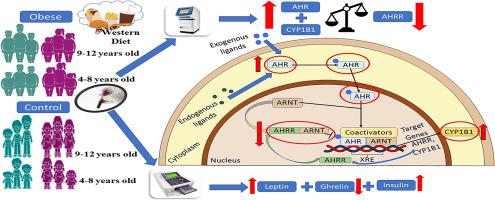当前位置:
X-MOL 学术
›
BBA Mol. Cell Biol. Lipids
›
论文详情
Our official English website, www.x-mol.net, welcomes your feedback! (Note: you will need to create a separate account there.)
Potential role of aryl hydrocarbon receptor signaling in childhood obesity.
Biochimica et Biophysica Acta (BBA) - Molecular and Cell Biology of Lipids ( IF 4.8 ) Pub Date : 2020-04-14 , DOI: 10.1016/j.bbalip.2020.158714 Nancy N Shahin 1 , Ghada T Abd-Elwahab 1 , Afaf A Tawfiq 2 , Hanan M Abdelgawad 1
Biochimica et Biophysica Acta (BBA) - Molecular and Cell Biology of Lipids ( IF 4.8 ) Pub Date : 2020-04-14 , DOI: 10.1016/j.bbalip.2020.158714 Nancy N Shahin 1 , Ghada T Abd-Elwahab 1 , Afaf A Tawfiq 2 , Hanan M Abdelgawad 1
Affiliation

|
BACKGROUND
There is a growing concern that junk food has contributed to the childhood obesity epidemic. Recently, experimental studies suggested that the aryl hydrocarbon receptor (AHR) gene is strongly linked to western diet-induced obesity.
AIM
This study investigated the potential role of AHR signaling in childhood obesity and the possible associations of the AHR-aryl hydrocarbon receptor repressor (AHRR)-cytochrome P450 1B1 (CYP1B1) axis with fatty acid homeostasis and the appetite-related hormones, leptin and ghrelin.
SUBJECTS AND METHODS
The study included 80 children; 54 obese and 26 non-obese of matched age and sex. Demographic data, anthropometric measurements, and lipid profile were assessed. Expression of AHR signaling genes was analyzed in blood cells by qRT-PCR. Serum insulin, leptin and ghrelin levels were measured using ELISA.
RESULTS
The statistical power of this study, calculated using G*Power version 3.1.9.2, was 90% (α = 0.05). AHR and CYP1B1 gene expression levels were upregulated in the obese group compared to controls, whereas AHRR, stearoyl-CoA desaturase 1 (SCD1), and peroxisome proliferator-activated receptor-γ2 (PPARγ2) were downregulated. Serum leptin correlated positively, while serum ghrelin correlated negatively with both AHR and CYP1B1. Stratification of obese children by age revealed more activated AHR signaling in younger than in older children. Receiver-operating-characteristic (ROC) analysis revealed that AHR, AHRR and CYP1B1 could discriminate between obese and normal weight children. Multivariate analysis showed that AHRR, CYP1B1 and ghrelin could be significant independent predictors of obesity.
CONCLUSION
This study provides new insights into the molecular mechanisms contributing to childhood obesity by revealing alterations in the AHR-AHRR-CYP1B1 axis, which could serve as a promising therapeutic target for childhood obesity.
中文翻译:

芳烃受体信号在儿童肥胖中的潜在作用。
背景技术人们越来越担心垃圾食品已经导致了儿童肥胖症的流行。最近,实验研究表明,芳烃受体(AHR)基因与西方饮食引起的肥胖症有很强的联系。目的本研究调查了AHR信号在儿童肥胖中的潜在作用,以及AHR-芳烃受体阻遏物(AHRR)-细胞色素P450 1B1(CYP1B1)轴与脂肪酸稳态和食欲相关激素,瘦素和生长素释放肽的可能联系。受试者与方法这项研究包括80名儿童。年龄和性别相符的肥胖者为54名,非肥胖者为26名。评估了人口统计学数据,人体测量学和脂质分布。通过qRT-PCR分析AHR信号转导基因在血细胞中的表达。使用ELISA测量血清胰岛素,瘦素和生长素释放肽水平。结果使用G * Power版本3.1.9.2计算得出的这项研究的统计功效为90%(α= 0.05)。与对照组相比,肥胖组的AHR和CYP1B1基因表达水平上调,而AHRR,硬脂酰辅酶A去饱和酶1(SCD1)和过氧化物酶体增殖物激活受体-γ2(PPARγ2)下调。血清瘦素与AHR和CYP1B1呈正相关,而血清ghrelin与AHR和CYP1B1呈负相关。肥胖儿童的年龄分层显示,年龄较小的儿童比年龄较大的儿童激活的AHR信号更多。接收者操作特征(ROC)分析显示,AHR,AHRR和CYP1B1可以区分肥胖和正常体重的儿童。多因素分析显示,AHRR,CYP1B1和Ghrelin可能是肥胖的重要独立预测因子。
更新日期:2020-04-14
中文翻译:

芳烃受体信号在儿童肥胖中的潜在作用。
背景技术人们越来越担心垃圾食品已经导致了儿童肥胖症的流行。最近,实验研究表明,芳烃受体(AHR)基因与西方饮食引起的肥胖症有很强的联系。目的本研究调查了AHR信号在儿童肥胖中的潜在作用,以及AHR-芳烃受体阻遏物(AHRR)-细胞色素P450 1B1(CYP1B1)轴与脂肪酸稳态和食欲相关激素,瘦素和生长素释放肽的可能联系。受试者与方法这项研究包括80名儿童。年龄和性别相符的肥胖者为54名,非肥胖者为26名。评估了人口统计学数据,人体测量学和脂质分布。通过qRT-PCR分析AHR信号转导基因在血细胞中的表达。使用ELISA测量血清胰岛素,瘦素和生长素释放肽水平。结果使用G * Power版本3.1.9.2计算得出的这项研究的统计功效为90%(α= 0.05)。与对照组相比,肥胖组的AHR和CYP1B1基因表达水平上调,而AHRR,硬脂酰辅酶A去饱和酶1(SCD1)和过氧化物酶体增殖物激活受体-γ2(PPARγ2)下调。血清瘦素与AHR和CYP1B1呈正相关,而血清ghrelin与AHR和CYP1B1呈负相关。肥胖儿童的年龄分层显示,年龄较小的儿童比年龄较大的儿童激活的AHR信号更多。接收者操作特征(ROC)分析显示,AHR,AHRR和CYP1B1可以区分肥胖和正常体重的儿童。多因素分析显示,AHRR,CYP1B1和Ghrelin可能是肥胖的重要独立预测因子。



























 京公网安备 11010802027423号
京公网安备 11010802027423号